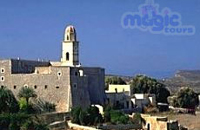Monastery of Toplou
 Within a distance of 10km from Palekastro.
Within a distance of 10km from Palekastro.
This is one of the most important and historic monasteries of Crete. Located 20k east of Sitia. Dedicated to the name of The Virgin Mary and to St. John the Theologian, it is still generally referred to as "The Great Monastery" by the people of Crete today.
The name of the Monastery Akrotiriani has been well known from the 15th or 16th century, as indicated by the bronze seals of the era. In 1673, the monastery was referred to for the first time as the Monastery of Toplou, according to a relevant Turkish document. According to historians, the name derives from the fact that there was a small cannon at the monastery as a defense against pirates. The word for cannon in the Turkish language is "Top". This is not entirely conclusive, but it is also considered that the "Plou" part of the name comes from an abbreviation of the Greek word "Plousio" which means "rich" (referring to the monastery), and the monastery indeed has extensive property. The time of its foundation is uncertain. When the last wall paintings were uncovered, experts have come to the conclusion that the small Temple of the Assumption of the Virgin Mary which was constructed in the 14th century became the central point of the monastery. During its history, the monastery has experienced many incidents.
It also played an important role in the history of Eastern Crete, and was the repository of its religious and national traditions. During the period 1460-1471, the monastery was completely destroyed by Turks who were probably pirates. It was rebuilt according to the fortress system of the era, to be defended against pirates who were dangerous during that time. According to another story, the great family of Kornaron built the monastery. In 1530, the Knights of Malta plundered the monastery. In 1612 it sustained heavy damage from an earthquake, but was reconstructed quickly by the hard-working Prior from the Monastery of Pantogalo. In 1646, it fell into the hands of the Turks, who plundered the monastery and forced the monks to abandon it. In 1704, the monastery was dedicated as "Stavropiyiaki" (Constantinople dependant monastery). Because the monastery was a center for the Revolutionary movement, and a shelter for the persecuted, it was severely tested during the years of the Turkish occupation.
In 1821 when the Revolution was declared, the Turks slaughtered 12 monks at the entrance to the monastery. During the Revolution of 1855, the monastery promoted the national cause in many ways. During the German occupation, the monastery again played its nationalistic role. For this reason the Germans killed the Prior Ignatius Sylignakis, while other monks were imprisoned and tortured. In addition the monastery played a role in education. There is evidence that during the Turkish occupation, a hidden school was operating from there. From 1870, a cooperative school was established and carried out. Architecturally it has a square shape, and is enclosed by a strong high wall.
The main building of the monastery is 800 square meters, with three floors of a total height of 10m. Today the monastery has many precious treasures, even though some had been occasionally plundered by different conquerors. Of particular artistic value and inspiration are the two portable icons, the work of Ioannis Kornarou, one entitled "Great Thou Art, O Lord", and the other of the Saint Anastasia the Healer. Two ground-floor halls of the monastery operate today as museums. In one of them the Holy Scriptures are displayed, as well as gold and silver crosses, portable icons of exquisite artistry with the artists signatures, and vestments of the patriarch, and lead-covered seals etc.
